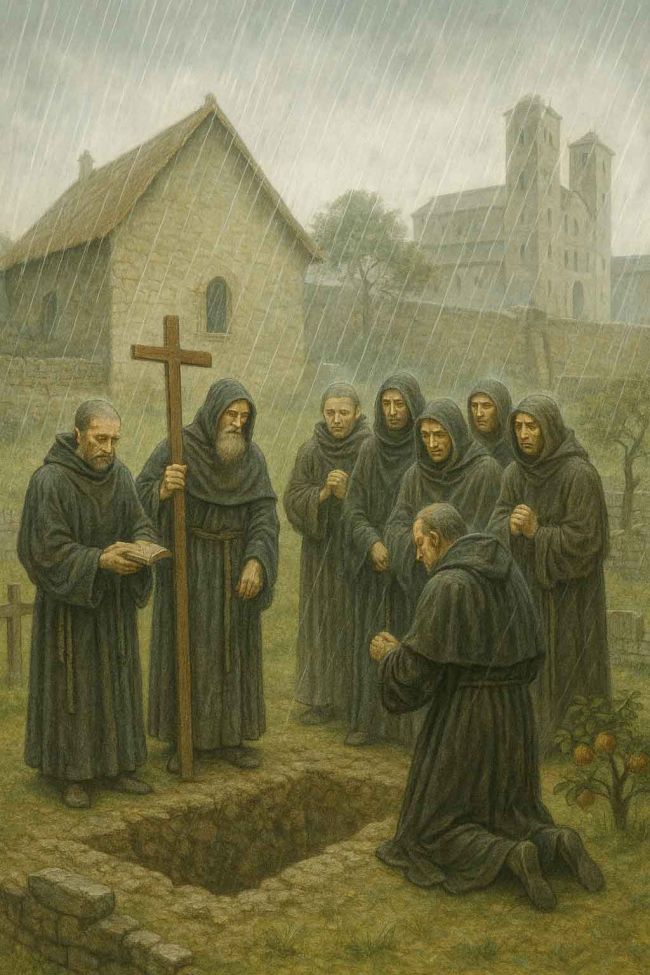Written by David Caldwell ·
Saint Swithin: Saxon Bishop, Rain God, and Orchard Guardian
For centuries, the name of Saint Swithin has conjured visions of rain-drenched summers and miraculously mended eggs. But who was the man behind the weather legend, and why did his feast day, 15th July, come to be so closely tied to the fate of harvests and the ripening of apples? In this article, we explore the life of St Swithin, his curious meteorological legacy, and his place in both Anglo-Saxon piety and English folklore.
The Real Saint Swithin
St Swithin (also spelled Swithun or Swithunus) was an Anglo-Saxon bishop of Winchester who died in 862 during the reign of King Æthelbald of Wessex. Born into a wealthy noble family, Swithin served as chaplain to King Egbert of Wessex and later as tutor to his son, Æthelwulf. He rose to become Bishop of Winchester around 852 AD, a position of significant influence and landholding in Saxon England.
Despite his high station, very little was written about his deeds during his lifetime. He requested to be buried humbly in the open air, "where the rain from heaven might fall upon his grave." This desire for a simple burial outside the cathedral reflected both humility and perhaps a wish to remain close to the people. Some later sources suggested that he wished to be buried like a simple monk. It was only a century later that tales of his miracles began to circulate, notably following the translation (i.e., ceremonial reburial) of his remains to a more prominent shrine inside Winchester Cathedral.
The Legend of the Rain
According to legend, the monks who moved his bones on 15th July were met with torrential rain, which lasted for 40 days. This was interpreted as a sign of divine displeasure. Thus, the superstition arose: if it rains on St Swithin's Day, it will continue for 40 days. If it is dry, fair weather will follow.
"St Swithin's Day, if thou dost rain, For forty days it will remain. St Swithin’s Day, if thou be fair, For forty days 'twill rain nae mair."
This idea may have had a basis in empirical observation. The jet stream stabilises around mid-July, often determining the weather for weeks. In agrarian societies, predicting a dry or wet spell during the crucial harvest period was vital. Thus, the day took on a predictive quality, especially for crops that could rot in heavy rain, such as apples.
Apples and Orchard Lore
In rural tradition, St Swithin was not only the bishop of rainfall but of orchards. It was said that apples would not ripen properly until after his feast day. Apple-picking was delayed until the weather had shown its hand. In some areas, the first apples were blessed in church after St Swithin’s Day. There is a deeper seasonal logic here: mid-July marks the turning point between early summer growth and late summer maturation. In orchard lore, apples that were "christened with rain" were seen as having passed a natural threshold and were then deemed ready to ripen.
A Miracle for Every Day?
St Swithin's popularity exploded in the 10th and 11th centuries. His shrine at Winchester became a major pilgrimage site, drawing visitors from all over southern England and even further afield. Ælfric of Eynsham, writing in Old English, lamented that no written record of Swithin's life had been preserved, yet he praised God for revealing the bishop's sanctity through "manegum wundrum" (many miracles).
According to the hagiographic text Miracula Sancti Swithuni, at least 42 miracles were attributed to him, possibly aligning with the 40 days of rain in the legend. These included healing the sick, the lame, the blind, and even repairing a basket of broken eggs. The number 40 carries biblical weight: 40 days of rain in the flood, 40 days of fasting in the wilderness, and 40 days between Easter and the Ascension. It may have symbolised a divine testing period.
The Pilgrim Route
Churches dedicated to St Swithin are mostly clustered in southern England, particularly around Winchester. Notable examples include:
- St Swithun-upon-Kingsgate, Winchester, built into the old city wall, possibly at the site of an earlier pilgrimage gate.
- Martyr Worthy and Headbourne Worthy, both near Winchester and thought to lie on a pilgrimage route.
- Nately Scures, near an ancient priory site at Andwell, with links to local river legends and a carved mermaid inside.
The concentration of these churches suggests a pilgrimage corridor connecting Winchester to Canterbury, or at least to other major religious centres. Many lie near springs, streams, or sacred water sources, a fitting location for a saint linked to rain and blessings.
European Rain Saints and the Seven Sleepers
St Swithin is not the only saint associated with summer weather. Across Europe, saints such as St Medard in France or St Godelieve in Flanders were invoked to bring or banish rain. In Germany, the legend of the Seven Sleepers of Ephesus (celebrated around June 27) held that the weather on their feast day would last for seven weeks. These were likely remnants of earlier pagan beliefs around seasonal transition points and weather divination.
Fact or Folklore?
While weather records such as those compiled in Greenwich in the 19th century showed mixed results for the 40-day claim, the belief persisted well into the 20th century. Some suggested that the calendar shift under the Gregorian reform moved the true date of St Swithin's Day to 27th July under the old Julian reckoning, closer to the time the jet stream typically stabilises.
A Prayer for Rain
In these times of climate change, long protracted heat waves, water shortages and drought, many still pray for rain in the middle of July, and thoughts turn to St Swithin.
Sources:
- Miracula Sancti Swithuni (translated excerpts)
- Ælfric's Lives of Saints
- 19th- and 20th-century newspaper accounts and weather reports
- Worthy Churches Project (https://worthychurches.org.uk)
- A Clerk of Oxford blog (https://aclerkofoxford.blogspot.com)
Related Articles
4 October 2025
The Ancient Blood: A History of the Vampire27 September 2025
Epona: The Horse Goddess in Britain and Beyond26 September 2025
Witchcraft is Priestcraft: Jane Wenham and the End of England’s Witches20 September 2025
The Origins of Easter: From Ishtar and Passover to Eggs and the Bunny12 September 2025
Saint Cuthbert: Life, Death & Legacy of Lindisfarne’s Saint7 September 2025
The Search for the Ark of the Covenant: From Egypt to Ethiopia5 September 2025
The Search for Camelot: Legend, Theories, and Evidence1 September 2025
The Hell Hound Legends of Britain25 August 2025
The Lore of the Unicorn - A Definitive Guide23 August 2025
Saint Edmund: King, Martyr, and the Making of a Cult14 August 2025
The Great Serpent of Sea and Lake11 August 2025
The Dog Days of Summer - meanings and origins24 June 2025
The Evolution of Guardian Angels19 June 2025
Dumnonia The Sea Kingdom of the West17 June 2025
The Roman Calendar, Timekeeping in Ancient Rome14 June 2025
Are There Only Male Angels?
